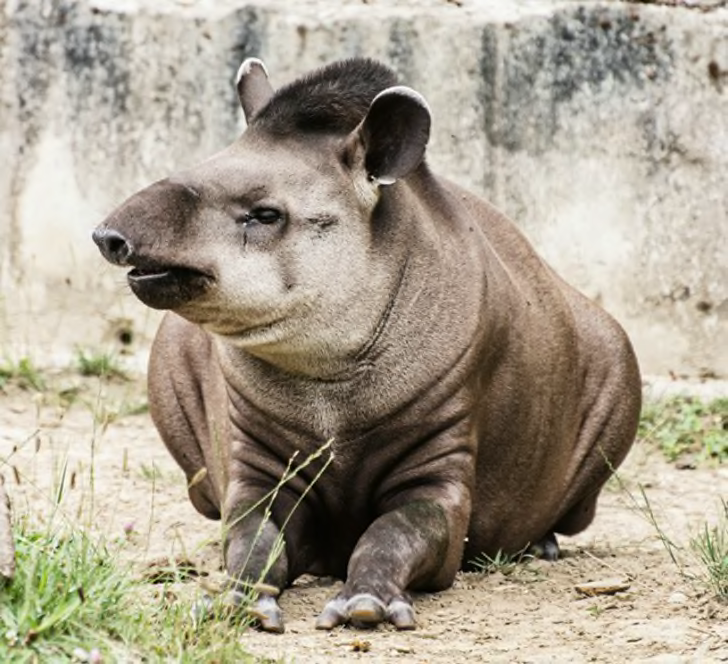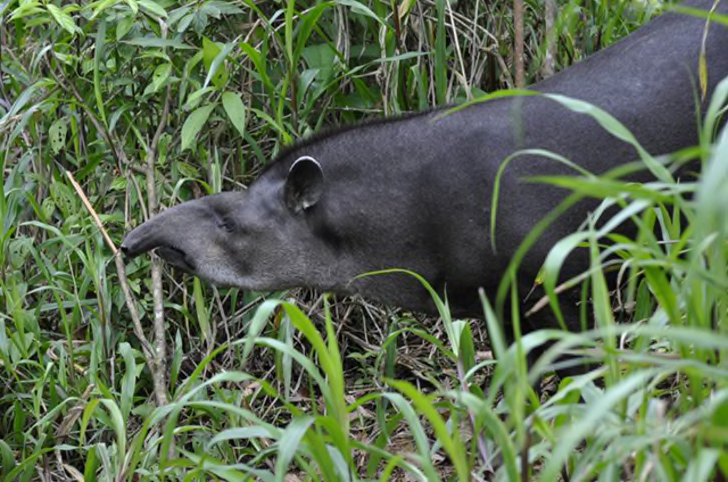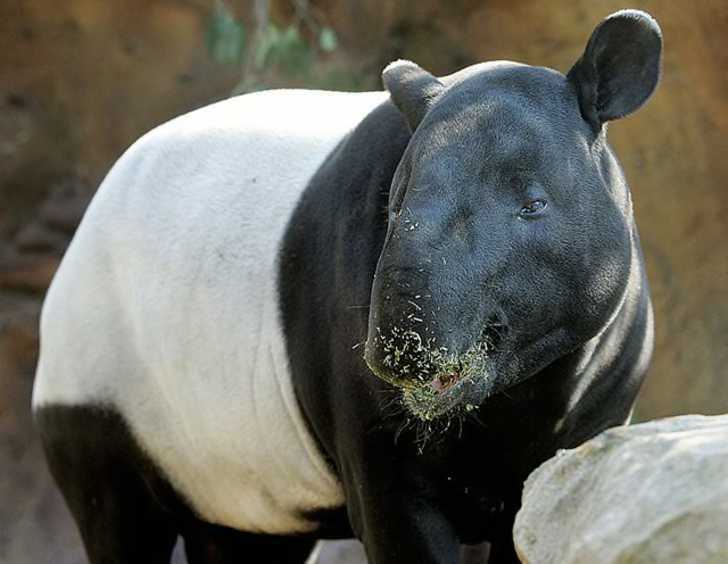So, which one is correct? That’s hard to say. The Merriam-Webster Dictionary suggests three pronunciations, as does this YouTube pronunciation series. Wikipedia has two pronunciations. This video from the Zoological Society of London is firmly in the TAY-pyer camp, but this one from National Geographic uses TAY-per. And, of course, Ze Frank loves his ta-PEER. The debate rages on.
14 Terrific Facts About Tapirs

Their noses are snorkels. They plant trees with their poop. They walk underwater. Meet a group of remarkable mammals who look sort of like pigs but are related to horses, and once lived around the world: the tapirs.
1. TAPIRS CAN GET PRETTY HEAVY.

Tapirs aren’t very tall—the largest doesn’t quite reach 4 feet at the shoulder—but they are rotund. The Malayan tapir, the only species native to Asia, can weigh 720 pounds or more. The other four species are smaller. In 2013, scientists described a new species, the kabomani tapir, which is the littlest, weighing an estimated 240 pounds or so.
2. THEY CAN GRAB THINGS WITH THEIR SNOUTS.

Tapirs’ upper lips are stretched out into long snouts that resemble elephant trunks. These flexible mini-trunks are prehensile, which means that they can grasp things—for example, a tapir may use its snout to pluck tasty leaves or put fruit in its mouth. Sometimes, a swimming tapir may even poke its snout out of the water and use it as a snorkel.
3. THEY MAKE THIS FACE.

Tapirs often curl their lips and raise their snouts, making a funny-looking face. What’s going on here? Is the tapir just really happy? Or is it about to sneeze?
This weird behavior has a name: it’s called the flehmen response. Giraffes, horses, house cats, and many other animals do it too—but it looks more impressive with a tapir’s snout. When these animals curl their upper lips, they’re using an extra-powerful sense somewhere between taste and smell. The action opens up a pair of ducts in their mouths to send material up into a special sensory body called the vomeronasal organ.
Often, critters make this face to glean extra info about other members of their species from substances such as urine. Just don’t try it yourself: you lack the equipment. Humans have lost those special ducts and vomeronasal organs.
4. BABY TAPIRS LOOK NOTHING LIKE ADULTS.

Though adult tapirs aren’t very colorful, baby tapirs are covered in vivid spots and zebra stripes. This pattern probably helps obscure their shape in the underbrush, enabling them to hide from predators such as big cats. Many other animals are speckled when they’re young, but lose their spots as they get older. For example, a lot of deer (think of Bambi) have speckles that fade with age.
5. TAPIRS HELP FORESTS THRIVE … WITH THEIR POOP.
Tapirs eat plants—and beyond that, they’re not picky. They live in warm, dense forests with diverse vegetation, and they’ll graze on grass, browse tree leaves, and chomp on twigs. Fruits and berries are an important part of their diet, too. And here’s where the poop comes in: Many seeds can survive the trip through tapirs’ digestive systems. As tapirs wander through the forest munching fruit, they poop out the seeds, spreading them to new locations.
One study found that 135 samples of lowland tapir dung contained seeds from an astonishing 122 plant species. Unintentionally, tapirs help disperse seeds from their favorite fruit trees, which means more fruit for tapirs—and other animals.
6. THEY HAVE SURPRISING RELATIVES.
Take a look at a picture of a tapir. Can you tell where it fits in the animal kingdom? Despite its snout, it’s not closely related to the elephants. And though it’s pretty portly, it’s not a pig or a hippopotamus.
Stumped? It turns out that tapirs’ closest relatives are rhinoceroses and horses. They all belong to a group called the “odd-toed” mammals—they have an odd number of toes (as opposed to an even number). Horses walk on one hoofed toe, and rhinos walk on three toes. Just to be confusing, tapirs have three toes on their hind feet and four on the front. And their feet look pretty weird.
7. TAPIRS CAN WALK UNDERWATER.

Tapirs love the water. They’re terrific swimmers and divers, and they enter water to cool off, dine on aquatic plants, avoid predators, and have sex. They can also walk—pretty quickly, even—on the bottom of a river or lake, as in the end of the video above.
8. DON’T FIGHT A TAPIR.
Tapirs may look like fuzzy, gentle plant-eaters. They’re typically very shy, and when they’re scared, they’re likely to flee.
But tapirs have a tough side. These animals are unpredictable and will fiercely defend themselves and their young, sometimes maiming or even killing people. In one high-profile case, the former Costa Rican Minister of Environment and Energy was attacked by a mother tapir when he tried to get a close look at her baby.
The bottom line? Tapir attacks are very rare, but you should always treat these animals with respect and give them the space they need to feel safe and comfortable.
9. THEY’RE PRETTY THICK-SKINNED, TOO.
Compared to their relatives, tapirs may seem defenseless. They lack a rhino’s horns or a horse’s speed. However, they have a very tough hide that helps protect them from predators and prevent injury as they push through dense forest. And though they may not look furry, tapirs are covered in short hairs. Mountain tapirs have especially thick fur to help them stay warm up in the mountains.
10. THEY WHISTLE.
You might expect tapirs to bellow or moo. But no, they make a high-pitched sound that the San Diego Zoo describes as “car brakes screeching to a halt”. When annoyed, they will also stamp their feet and snort.
11. THEY ARE CREATURES OF THE SHADOWS.
Tapirs are active at night. Specifically, they’re crepuscular. This term refers to dawn and dusk, and in zoology, animals that are most active at those times—like the tapir.
During twilight, these mammals will push happily through the dark forest looking for tasty plants.
12. THE MALAYAN TAPIR IS THE ODD ONE OUT.

All tapir species—except one—live in Central and/or South America. But the Malayan tapir lives all the way around the world in Southeast Asia. How did that one species wind up so far away from its closest cousins?
Tapirs are part of an ancient lineage that’s about 50 million years old. They once roamed many parts of the world, with tapirs happily munching leaves in Europe, North America, and China. But as temperatures cooled and the continents continued to shift, tapirs’ warm forests shrunk and moved south.
These changing conditions prompted some animals to adapt to new habitats, such as the grasslands that now covered much of the land. But tapirs were creatures of habit. They stuck with their forests, remaining relatively unchanged for millions of years. So, today’s tapirs are the last survivors of a once internationally successful group.
13. TAPIRS ARE IN TROUBLE.

Here’s the bad news: all tapirs are facing serious threats to their survival.
According to the International Union for Conservation of Nature's Red List of Threatened Species, Baird’s tapir is classified as Endangered due to habitat loss and hunting; the population has more than halved in recent decades. The Endangered mountain tapir is in a similarly dire situation. Hunting, habitat loss, and competition for livestock are driving down numbers of the lowland tapir, which is labeled Vulnerable. And the sole Asian species, the Malayan tapir, is also Endangered.
But there’s still time to save tapirs. The IUCN’s Tapir Specialist Group offers some ways to help, including supporting conservation groups and visiting tapirs on ecotourism trips.
14. HOW DO YOU PRONOUNCE “TAPIR,” ANYWAY?

While you’ve been reading this article, how have you been pronouncing “tapir” in your head? If you’re feeling uncertain about the pronunciation, don’t worry—you’re not alone.
The word tapir comes from the language of Brazil’s indigenous Tupi people, who called it “tapyra.” These days, English-speaking people seem to say it at least four different ways: 1. ta-PEER, 2. TAY-per (so that it sounds like “taper”), 3. TAY-peer and 4. TAY-pyer
Tags:
Replies to This Discussion
-
Permalink Reply by Arachnifauna on March 2, 2020 at 4:00pm
-
thanks for posting for me..
-
-
Permalink Reply by Carmen Elsa Irarragorri Wyland on March 2, 2020 at 4:29pm
-
You are welcome, yes, it is a very interesting animal, for sure, and also an endangered species, and we have to prevent that!
-
-
Permalink Reply by Arachnifauna on March 2, 2020 at 5:33pm
-
absolutely
-
Have questions?
Need help? Visit our Support Group for help from our friendly Admins and members!
Have you?
Donations & Sponsorship
Connect
Visit The Temple
on Facebook:
Blog Posts
Channeled Angelic Wisdom of the Jewels of Truth Series on Chaos & Lust
Posted by Atrayo on July 22, 2025 at 9:00am 0 Comments 0 Likes
FLEET OF LIGHT!
Posted by Rosey Cross on July 18, 2025 at 5:07pm 0 Comments 0 Likes
Perdition
Posted by The Draç (李) on July 13, 2025 at 12:30am 0 Comments 0 Likes
RICO
Posted by The Draç (李) on July 11, 2025 at 6:00pm 0 Comments 0 Likes
Death Wish
Posted by The Draç (李) on July 11, 2025 at 6:30am 0 Comments 0 Likes
What Is an Earth Angel?
Posted by Bill Walker on July 7, 2025 at 7:13pm 0 Comments 0 Likes
Survivor
Posted by The Draç (李) on July 1, 2025 at 1:37am 0 Comments 0 Likes
Darth Maul
Posted by The Draç (李) on June 30, 2025 at 7:30am 0 Comments 0 Likes
God Consciousness and The Great Spirit
Posted by Bill Walker on June 25, 2025 at 9:26pm 3 Comments 1 Like
Channeled Angelic Wisdom of the Jewels of Truth Series on Sleeping Dreams and So Below, As Above
Posted by Atrayo on June 25, 2025 at 8:21pm 0 Comments 1 Like
It's Jehovah
Posted by The Draç (李) on June 18, 2025 at 4:39pm 0 Comments 1 Like
The (NEKH-T) (3l)ohim
Posted by The Draç (李) on June 16, 2025 at 8:00am 0 Comments 0 Likes
The Hidden Temple
Posted by The Draç (李) on June 12, 2025 at 4:00am 0 Comments 1 Like
The Shenlong
Posted by The Draç (李) on June 10, 2025 at 12:00pm 0 Comments 0 Likes
Channeled Angelic Wisdom of the Jewels of Truth Series on Angelic Contempt for Humanity & God's Rebuttal of Angelic Contempt
Posted by Atrayo on June 8, 2025 at 9:42pm 0 Comments 1 Like
The Devil's Prophet
Posted by The Draç (李) on June 7, 2025 at 11:00am 0 Comments 0 Likes
The Archdevil(s)
Posted by The Draç (李) on June 5, 2025 at 10:30am 0 Comments 0 Likes
STONE OF YELLOW!
Posted by Rosey Cross on June 2, 2025 at 6:30pm 1 Comment 4 Likes
The Archdevil
Posted by The Draç (李) on June 1, 2025 at 7:30am 0 Comments 0 Likes
The Roc Nation Bloodline
Posted by The Draç (李) on May 28, 2025 at 2:35pm 0 Comments 0 Likes
NOVEMBER AWARENESS
Videos
© 2025 Created by Bryan
Powered by
![]()